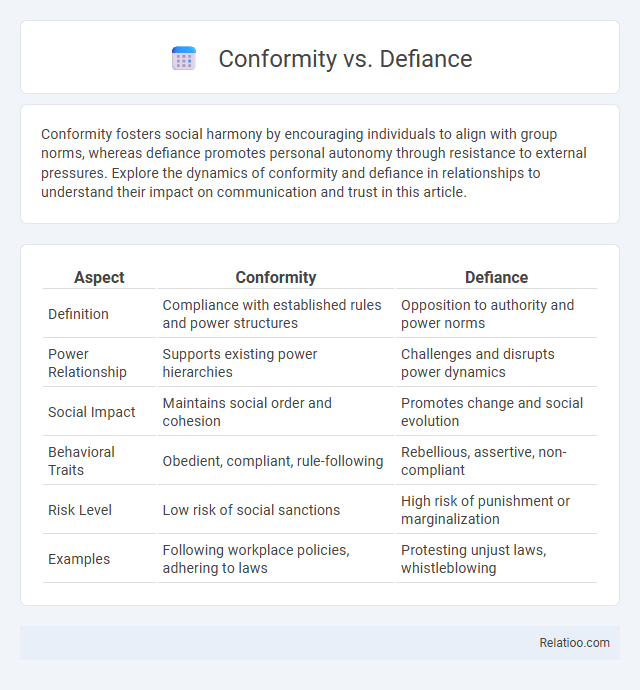Conformity fosters social harmony by encouraging individuals to align with group norms, whereas defiance promotes personal autonomy through resistance to external pressures. Explore the dynamics of conformity and defiance in relationships to understand their impact on communication and trust in this article.
Table of Comparison
| Aspect | Conformity | Defiance |
|---|---|---|
| Definition | Compliance with established rules and power structures | Opposition to authority and power norms |
| Power Relationship | Supports existing power hierarchies | Challenges and disrupts power dynamics |
| Social Impact | Maintains social order and cohesion | Promotes change and social evolution |
| Behavioral Traits | Obedient, compliant, rule-following | Rebellious, assertive, non-compliant |
| Risk Level | Low risk of social sanctions | High risk of punishment or marginalization |
| Examples | Following workplace policies, adhering to laws | Protesting unjust laws, whistleblowing |
Understanding Conformity: Definition and Origins
Conformity refers to the act of aligning thoughts, behaviors, and attitudes to match group norms or societal expectations, fundamentally rooted in social influence and the desire for acceptance. Psychologists identify normative conformity, driven by the need for approval, and informational conformity, based on the assumption that others' interpretation of a situation is more accurate. The origins of conformity trace back to early human societies where cohesive group behavior was crucial for survival, reinforcing social norms and cultural continuity.
The Psychology Behind Defiance
Defiance in psychology represents an individual's conscious choice to resist authority or social expectations, stemming from intrinsic motivation to assert autonomy and challenge perceived control. Your tendency toward defiance may be linked to psychological factors such as self-identity formation, need for independence, and reactions to perceived injustice or pressure. Understanding these underlying mechanisms illuminates why defiance often serves as a critical step between passive conformity and active rebellion in behavioral responses.
Social Influences on Conformity
Social influences on conformity operate through mechanisms such as normative social influence, where individuals align their behaviors to fit group expectations and avoid social rejection, and informational social influence, which occurs when individuals look to others for guidance in ambiguous situations. Factors like group size, unanimity, cohesion, status, and culture significantly affect the likelihood of conformity, with higher conformity rates often observed in collectivist societies. Your awareness of these social dynamics can help you recognize when conformity arises from external pressures rather than personal conviction.
The Role of Authority in Shaping Behavior
Authority significantly influences conformity by establishing social norms that individuals often follow to gain acceptance or avoid punishment. Defiance emerges when individuals consciously resist these norms, asserting personal autonomy despite potential consequences. Your understanding of this dynamic reveals how rebel behaviors challenge or reshape the power structures imposed by authority figures.
Consequences of Defying Social Norms
Defying social norms often results in social ostracism, loss of trust, and potential legal ramifications depending on the severity of the defiance. Individuals who rebel against established conventions may face psychological stress, damaged relationships, and reduced opportunities in professional and personal spheres. However, such defiance can also spark social change by challenging outdated or unjust norms, ultimately influencing cultural evolution.
Benefits and Risks of Conformist Attitudes
Conformist attitudes offer benefits such as social acceptance, reduced conflict, and smoother group cooperation, which can enhance your ability to function effectively within communities or organizations. However, these attitudes carry risks including loss of individuality, suppression of creativity, and vulnerability to unethical groupthink, potentially leading to poor decision-making or stagnation. Balancing conformity with critical thinking allows you to maintain social harmony while preserving personal integrity and innovation.
Historical Examples: Conformity and Defiance in Action
Historical examples of conformity highlight how societies maintained order through adherence to prevailing norms, such as citizens complying with laws in ancient Rome. Defiance is exemplified by individuals like Rosa Parks, whose refusal to conform to segregation laws sparked significant civil rights movements. Understanding these moments reveals how your choices can either uphold stability or challenge unjust systems in history.
Cultural Perspectives on Obedience and Rebellion
Cultural perspectives on obedience and rebellion vary significantly, with collectivist societies emphasizing conformity and valuing harmony, while individualistic cultures often celebrate defiance as a form of personal freedom and self-expression. You navigate complex social landscapes where obedience upholds traditional values and social order, whereas rebellion can signal resistance against perceived injustice or cultural shifts. Understanding these dynamics is crucial for interpreting behaviors within diverse cultural frameworks and the societal impact of conformity versus acts of defiance.
Group Dynamics: Peer Pressure vs. Individualism
Group dynamics significantly influence your behavior through the tension between conformity, defiance, and rebellion. Peer pressure drives conformity by encouraging adherence to group norms, while individualism fosters defiance by promoting personal values that challenge collective expectations. Rebellion emerges when individuals or subgroups reject established norms, creating a dynamic interplay that shapes social identity and group cohesion.
Finding Balance: Navigating Between Conformity and Defiance
Navigating between conformity and defiance requires a delicate balance that fosters personal authenticity while respecting social norms. Embracing selective conformity enables smooth social integration, whereas strategic defiance challenges unjust systems and promotes growth. Mastering this dynamic balance supports healthy relationships and advances individual and collective progress.

Infographic: Conformity vs Defiance
 relatioo.com
relatioo.com